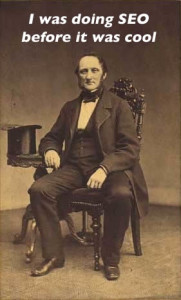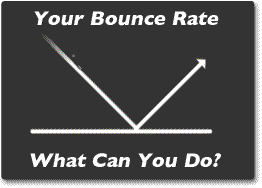I’ve been working in the SEO business for over 15 years and a lot has happened in that time:
- Meta Keyword Tags are long gone as a ranking factor. Even though many will tell you that they’re crucial. If an ‘SEO Expert’ says they are, that’s your cue to end the conversation and run. Far and fast.
- Link Strategies like 3-Way-Linking (I link to you, you link to the 3rd guy and the 3rd guy links to me), Mass Directory Submissions and putting your Link in Blog Comments are not only worthless now, they can even penalize you.
- Keyword Percentages on a Page used to be a thing, meaning if you used your targeted keyphrase a certain number of times, or percentage of the time, on a webpage, you’d rank for it.
Instead now you have to see you website as a whole. How does it look and operate in a mobile device? Is it easy for visitors to get to the important pages and content? Is your content well written, relevant to both your industry and your prospect’s needs and is it laid out for easier consumption?
While keywords are still important, the focus has broadened considerably to everything from the above to how fast the page(s) load.
Plus, your site is now ranked based on its mobile version. Your desktop version of the site is still very important, but with most visitors using mobile devices to browse, the priority has changed.
Yet I still see all kinds of businesses who clearly haven’t even created a mobile friendly website. It’s just their desktop version shrunk down and you have to keep stretching and pinching it to get anywhere. Incredible.
SEO Resources You Can Count On
So, how do I keep up with this ever-shifting, ever-evolving target? Here’s some sources I use and have found to be a lot of help in keeping current on Google’s algorithm and SEO:
- Search Engine Journal – I signed up for the daily email of their news updates and it’s always good. You should do the same.
- Moz – They are a Paid Service company, but also have some good Free SEO tools as well as learning resources and a regularly updated blog on the SEO world. Very well known authority.
- Search Engine Land – Always up on what’s happening as well as how-to articles and primers that are very good. Sign up for the email updates to stay on top of things.
- Search Engine Watch – Great resources, like white papers & case studies, along with deep articles that cover it all. Plus up to date looks at new ranking factors and changes.
There you have it. Not an exhaustive list, but that’s the point. You can only have a few real Go-To’s with the limits on your time and attention.
You just have to be sure they’re on top of things and that you can trust them. These 4 fit the bill.
Enjoy!
Tags: Other · SEO · SEO Tips
 When a real, flesh and blood human being arrives on your website, what does it say to them?
When a real, flesh and blood human being arrives on your website, what does it say to them?
Is your text cold and uninviting?
Does it feel like that person who answered the phone at that business you called once who made you feel like you were just a number to them?
Your on-site marketing, unfortunately, can feel the same way to YOUR customers.
Internet Marketing extends to your content, your text, your engagement and interaction with the people stopping by your online storefront.
How you make them feel is one of the prime foundations of the road to a Sale. What do we mean?
The Human Touch in Internet Marketing
It’s not about fake compliments or other tactics that fall flat. It’s about speaking to the visitor’s wants and needs. Clearly & Directly.
Empathize with their problem – the very reason they’re on your website seeking a solution. Give them understanding. Don’t go overboard, just an acknowledgement is enough.
Then tell them what you can do for them. But do it right.
It’s the old, but eternally correct, technique of emphasizing Benefits, not Features. Your product doesn’t just inflate tires to the right level with the touch of a button inside the car, it’s a money saving device.
Drivers save cash spent on gasoline because properly inflated tires give better mileage.
Your app doesn’t just summarize any book with a scan from your smartphone, it opens your mind and the minds of your children to new reading experiences that you never would’ve had before.
Your app makes them smarter, more cultured human beings!
Connect the dots between what you do, or what you sell, and the person’s needs – their deepest if possible and appropriate.
Talk to them as human beings, not as statistics from your analytics data.
Remember, your marketing works when you speak to your audience like a friend, a concerned neighbor or even a family member.
Not a cold robot who’s playing a numbers game.
Tags: internet marketing
This actually applies to just AdWords users, but it’s a sign that Google wants to make their Google My Business reviews a bigger player. This won’t push Yelp off the top of the heap just yet.
It DOES mean you should pay closer attention to getting reviews going there, however. Here’s what just happened.
Google has announced that you can show your Google reviews star rating with your AdWords ads now.
It’s a new part of their Locations extension. For those who have been diligent about requesting those reviews, it could be a huge advantage.
Whose ad would you click on, knowing nothing else about the businesses – one with a 4 or 5 star rating from reviewers or one without any reviews at all? I think we both know the answer.
Google has already shown the reviews as part of the map listings at the top of the organic listings, so this is one more reason to get moving on this. So far Google My Business reviews have been lower on the priority list. It’s time to move them up.
Tags: Google · Google AdWords · Pay Per Click (PPC) or Paid Search · search engine news
Let’s imagine you’re trying to fix your car. There’s a problem with it that you just can’t figure out so you take a break and take a walk.
As you make your way down the sidewalk you run into a friend. You tell them about your car problem and he say’s ‘I know exactly what you need!’.
He tells you about a unique tool you can only get at a certain store in town that will fix the issue in no time.
Tells you what it looks like, it’s dimensions, its color, everything.
Then he remembers he’s late to meet his wife and hurriedly takes off down the street – without telling you what store has the tool. How would you feel?
You’re doing the exact same thing to your potential customers and clients by forgetting to use a Call To Action across your website.
You sell the visitor on your product, your service, your business, but then don’t tell them what to do next. You pitch for the sale and forget to close. How smart is that?
When a reader gets to the bottom of a page, they immediately think ‘What Next?’. ‘Where do I go to find out more?’ and ‘How do I take advantage of this incredible offer?’.
Without a Call to Action you’ve left them high and dry, wondering what and where to proceed. By taking them out of the flow like that you’ve just trashed all the hard work you did selling them up to that point.
Do you really expect them to hunt around in a medium like the Internet, where your competition is just a click or two away, ready to do the job you didn’t?
At the bottom of every page, you need to have that CTA in place, whether it says ‘Click Here to Buy Now’ or ‘Find out More About Our Services’.
If you don’t, you leave the exit door wide open for them to leave. Lead them onward. Even if it’s not time to close the sale, by leading them to more content that’s relevant you increase the chances of gaining a new customer.
The longer they stay, the more they see, the more likely it is that they’ll step forward and become a client. This is Marketing 101.
Look at your website and the marketing environment you’ve set up. Are you making it simple for people to make the decision to buy – and go to that order page?
Are you telling them you’ve got more information on your services and linking directly to it, making it simple for them to learn more?
If not, you’re cheating yourself and your business. A Call to Action must be part of every page of your website in one way or another. Don’t wait.
Look at your online presence now and you’ll be amazed how much you’ve missed.
Tags: internet marketing
Google+ is known best as the poor counterpart to Facebook. A lot less people, a lot less interaction and rarely in the news. Still, your business ignores it at your peril. Here’s why.
1. Do you want to get into those map listings that show at the top of Google search results? If so, you need to get your Google+ business page up and optimized. NOW. A position there can mean a huge upswing in visitors to your site, so why wouldn’t you do it?
2. Google may have created a Google+ page for your business already. That’s not good news. They populate it with the most basic of information, possibly leaving out such essentials like your phone number or website address. They also don’t put up pictures for you, leaving it to look very amateur, which makes you look amateur too. Is that how you want to present your business? First impressions are everything.
3. Google+ reviews of your business will make that top map listing stand out even more to a potential customer. Whose listing would you click on – the one with no reviews or the one who has a 5 Star Rating from past clients? We both know what the answer is.
You need to get on Google+, take care of your business presence there and keep it updated, too. Take advantage of the tools and benefits that Google is giving you – Free. If you don’t, you’re only hurting yourself. And your business.
Tags: Google · internet marketing · search engine ranking · SEO · SEO Tips
There’s 2 camps when it comes to PPC. Those who think it’s a waste of time and only want ‘Free’ clicks through organic SEO (which isn’t really free).
Then there’s those who are on the fence, going back and forth about whether to try it out. Rarely do you come across the client who wants to charge forward into PPC, full speed ahead. That’s understandable.
Done wrong or rashly you can burn through your budget quickly, with little to show for it. That’s why you need to approach it with some solid pre-planning and thought so you can head that off.
In many cases PPC is worth a shot, you just have to be step forward smartly. Here’s 3 questions you need to answer BEFORE you put down your credit card.
1. Do you have someone who knows the system running your campaign? This is very important. It’s more than just pasting in a list of keyphrases you think are relevant.
For instance, there are different matching options, such as whether to show your ad only if the searcher uses that exact phrase in that exact word order or if they match only some of the words.
Not using those match options is a ticket to blowing through your money in no time. That’s just one aspect of running a campaign. There’s a lot more besides. You need a professional who is experienced in running PPC campaigns or else it can be like playing poker blindfolded.
Get someone in there who knows what they’re doing, just as you would with any other marketing and advertising effort.
2. Where will you send the searcher(s) when they click on your ad? The mistake many make is to send everyone to the same place – your homepage. Wrong.
In most cases you have specific products or services you are selling, each with its own customers. An accountant has tax preparation, tax planning and even separate personal and business tax services.
You want to not only target keyphrases in each of those areas, you also want to send each area’s ad click to a page specifically about that service.
Don’t add an extra step by sending everyone to the homepage and expect them to find their way to the service they need.
You’ll lose customers with each added step you make them go through. Send the directly to the content that talks directly to them and you raise the rate of success immediately.
3. What do I say in the ad? If you hire a professional they will probably handle this for you, but you should still take a look at what they’ve come up with. #1 on your list here is using the keywords in the ad that your targeting.
When they match up, Google will bold them, making your ad stand out more. Second, you need to give a benefit. Are you the fastest? oldest? #1 Seller? Tell them!
Generic statements like ‘we work hard for you’ won’t hook anyone. They just get lost in a sea of ‘Me Too’ pitches that line the Google results, making you anonymous and unremarkable.
Be specific about how you will uniquely benefit the customer. Finally, have a Call To Action. Visit Us, See Now, Click Here.
There’s not a lot of room in Google Ads, or any other PPC program, so this is hard to get in sometimes. Still, there’s something about an urging to the reader that raises the Click Thru Rate so use that space and tell them what to do next.
Or else resign yourself to letting them go onto the next ad – your competitor’s.
There’s much, much more to a successful, profit-busing Pay Per Click campaign, but these will give you a sold foundation for starting.
If you’re determined to dive in and handle it yourself, I highly recommend you do some reading online or read a book by Perry Marshall.
Make sure that the sources you consult are recent, though! Things change fast in PPC, just as they do in SEO.
It’s not an easy road, but it is rewarding, if you have the right person in charge.
Tags: search engine marketing · Facebook Ads/PPC · Google AdWords · Pay Per Click (PPC) or Paid Search
Some of these techniques aren’t just 50 years old, some are a century (or more) old now.
SEO, more and more, is relying on what advertisers and copywriters were doing decades ago to get their materials read and sales made.
Keep in mind that many of the men, and some women too, that we’re talking about wrote sales letters that were mailed.
All they had were words and a few illustrations to persuade people hundreds or thousands of miles away to mail money back for the offered product.
Here’s one example of how what they did is stunningly relevant still today in the digital world.
The Headline
Headlines, as any good copywriter from the 1920’s knew, was the most important element to an ad or sales letter.
It had to speak to the reader about their needs and desires in unmistakable terms, drawing them into the rest of the pitch.
If the headline didn’t do its job, that was the end of a sale before it even got started. It could also mean the end of their employment.
Today’s SEO headline are the Page Titles and Headings that have to have the same relevance to your modern searcher.
The use of keyphrases and related terms reflects back to the reader, confirming their needs will be met on this website.
It’s not just that they contain those words, however, that make them relevant, and rankable, in Google’s algorithm.
It’s also the readability and quality of those Headlines that matters to us in search engine optimization.
With the advances in search bot software, Google can now understand the difference between a well-written Title or Heading and a laundry list of keyphrases stuffed on the page in a ham-handed effort to rank for every one of them.
Robert Collier Predicts SEO in 1930
Robert Collier, a phenomenally successful copywriter from the early 20th Century, wrote that effective sales writing had to ‘enter the conversation’ inside the prospect’s head.
In other words, you needed to speak to them in words and language that they used within about their own wants and needs. Sounds a little like Keyphrases, doesn’t it?
That is simplifying a little, but it is accurate because it’s where you need to start – with the words searchers are using to find what you sell or provide.
If you want to truly stand out in your content, you need to read some of the advertising books that were written 40, 50, even 100 years ago.
Look for names like Claude Hopkins, Robert Collier and John Caples. It’s like they say, “The more things change, the more they stay the same.”
It’s just as true about SEO as anything else.
Tags: Google · search engine ranking · SEO
Bounce Rate is part of the SEO, and internet marketing, world that’s pivotal to your profitability on line.
It’s the measurement of visitors who land on your site and then leave without going any further.
If you lose that business consistently, it’s deeply affecting your bottom line. It’s also a ranking factor that could be bringing you down, damaging you further.
Most think of your homepage as the only entrance, but that just isn’t true.
If you look at your Analytics data you’ll see that traffic arrives on a variety of your pages, though the home page will probably dominate.
What can you do to bring that bounce rate down and keep these potential customers on-site?
I was going to write something on this, but then realized I’d already written an article a while back that is still 100% relevant.
You’ll learn what the right bounce rate is plus concrete steps on how to improve it right now. Read it here:
The Truth About Bounce Rate Article
Tags: Google · internet marketing · SEO
Do a search on Google for a local business. Doesn’t matter what kind it is, just use broad, general terms. Pretend you don’t know any businesses that do, or provide, whatever it is you need, like ‘Honolulu auto repair’.
Chances are you’re going to see a lot of listings with titles that are basically just lists of keyphrases they want to rank for, like ‘Car Mechanic in Honolulu – Oil Change, Body Paint, Auto Repair Hawaii…’.
Some are much, much worse, trailing off with those 3 dots because the laundry list of keywords goes on long after the allotted space Google shows runs out.
This doesn’t just apply to Page Titles, it also apples to headings on the site pages.
What happened is someone read that getting keyphrases in there is the way to rank, so they just started packing them in wherever they could. That’s what they think SEO is. They’re wrong. Very wrong.
The Decline of Packed Page Titles in Google Is Already Here
We need to acknowledge that you don’t see these offenses on the Page 1 results of Google nearly as much as you used to – and that’s precisely the point.
Google specifically wants logical, readable titles and headings now. Why? Because they communicate quality to the typical searcher.
Those keyphrase stuffed titles are the equivalent of the used car salesmen promising you the best deal in town. They’ll say anything and everything to get you to sign the deal.
That approach doesn’t inspire trust. Fail that test and you’ve lost a customer before you know it.
That directly affects the effectiveness of your Internet Marketing, which hinges on trust. SEO feeds that confidence, and vice versa now. When it’s done right, that is.
Take a look at your Title and Headings. How do they read? Problems. Try this easy solution.
Use the pipe – | – to separate phrases into bite-sized, understandable and readable chunks that actually say something. Instead of trying to say EVERYTHING at once.
The benefits of good writing and communication are there if you take advantage. It’s all part of SEO in the modern age.
Tags: Google · internet marketing · search engine marketing · search engine ranking · SEO
In the past you could still rank in competitive markets even if your site was purely about your business and your products.
As long as your website was optimized well and you used some of the other beneficial SEO techniques and practices, you could do well in Google.
That is a much harder path to search engine success now, though.
It’s been said countless times, especially online, but Content is King. That means a lot more now in the advanced algorithm we’re dealing with now in the Post-Penguin/Panda/Etc environment.
So what should you be doing?
Simple. What’s been suggested for a long time. Helpful, relevant, engaging content. You can’t just sell You and Your Services anymore.
Not just because Google wants that new focus. It’s what your potential customers and clients want, too. Here’s why.
How Helpful Content Feeds Both Google & Your Audience What They Need
Today’s shopper expects more. If you sell accessories for women, they want a guide or suggestions on what clothes, shoes, etc they can wear with them.
If you sell kitchen appliances, they want recipes or tips on using them to make the best tasting dishes possible.
If you’re a financial advisor, you want to give advice on certain kinds of investments and who should use them. This deeper content does 2 crucial things.
It not only feeds the wants and needs of your targeted audience, it also demonstrates your expertise and the benefits of your products or services.
In other words, it helps you to sell, without selling.
Look at the questions and concerns that your market want the answers to and address that in articles and blog posts on your website:
- What do they want to know about your industry or your products?
- What concerns do they have before – and after – buying or committing?
- What reasons do they give for not buying?
Those questions are a deep well of ideas for content. Once you’ve got an article done, post links to it on your social media accounts to get additional traffic and benefits from this content.
Sales has always been more about Them than You. That’s how SEO is, too.
Fulfill the needs of your customers and you’ll be ranking higher and in the places where they’re looking. That’s the best place to be.
Tags: Google · search engine ranking · SEO

 When a real, flesh and blood human being arrives on your website, what does it say to them?
When a real, flesh and blood human being arrives on your website, what does it say to them?

